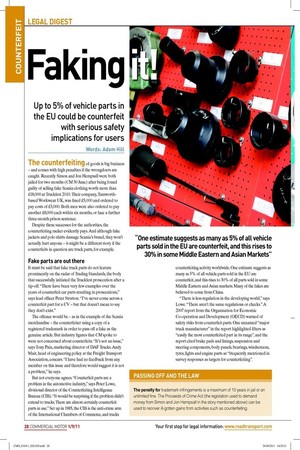Faking
Page 24

Page 25

If you've noticed an error in this article please click here to report it so we can fix it.
Up to 5% of vehicle parts in the EU could be counterfeit with serious safety implications for users
Words: Adam Hill
The counterfeiting of goods is big business – and comes with high penalties if the wrongdoers are caught. Recently Simon and Jon Hempsall were both jailed for two months (CM 30 June) after being found guilty of selling fake Scania clothing worth more than £18,000 at Truckfest 2010. Their company, Tamworthbased Workwear UK, was ined £5,000 and ordered to pay costs of £3,000. Both men were also ordered to pay another £8,000 each within six months, or face a further three-month prison sentence.
Despite these successes for the authorities, the counterfeiting racket evidently pays. And although fake jackets and polo shirts damage Scania’s brand, they won’t actually hurt anyone – it might be a different story if the counterfeits in question are truck parts, for example.
Fake parts are out there
It must be said that fake truck parts do not feature prominently on the radar of Trading Standards, the body that successfully initiated the Truckfest prosecution after a tip-off. “There have been very few examples over the years of counterfeit car parts resulting in prosecutions,” says lead oficer Peter Stratton. “I’ve never come across a counterfeit part for a CV – but that doesn’t mean to say they don’t exist.” The offence would be – as in the example of the Scania merchandise – the counterfeiter using a copy of a registered trademark in order to pass off a fake as the genuine article. But industry igures that CM spoke to were not concerned about counterfeits. “It’s not an issue,” says Tony Pain, marketing director of DAF Trucks. Andy Mair, head of engineering policy at the Freight Transport Association, concurs. “I have had no feedback from any member on this issue and therefore would suggest it is not a problem,” he says.
But not everyone agrees. “Counterfeit parts are a problem in the automotive industry,” says Peter Lowe, divisional director of the Counterfeiting Intelligence Bureau (CIB). “It would be surprising if the problem didn’t extend to trucks. There are almost certainly counterfeit parts in use.” Set up in 1985, the CIB is the anti-crime arm of the International Chambers of Commerce, and tracks counterfeiting activity worldwide. One estimate suggests as many as 5% of all vehicle parts sold in the EU are counterfeit, and this rises to 30% of all parts sold in some Middle Eastern and Asian markets. Many of the fakes are believed to come from China.
“There is less regulation in the developing world,” says Lowe. “There aren’t the same regulations or checks.” A 2007 report from the Organisation for Economic Co-operation and Development (OECD) warned of safety risks from counterfeit parts. One unnamed “major truck manufacturer” in the report highlighted ilters as “easily the most counterfeited part in its range” , and the report cited brake pads and linings, suspension and steering components, body panels, bearings, windscreens, tyres, lights and engine parts as “frequently mentioned in survey responses as targets for counterfeiting” . A respondent from the truck industry said that the scope of products being infringed remains relatively constant, but the number of infringements it has detected has increased. A 2009 study from the US-based Motor & Equipment Manufacturers Association’s Brand Protection Council highlighted igures from the Federal Trade Commission and World Customs Organisation in Interpol, which said counterfeiting costs the global motor vehicle parts industry $12bn (£7.3bn) a year. Of course, a signiicant proportion of this will speciically involve fake car – rather than truck – parts, but it is an eye-watering sum of money. India’s Automotive Component Manufacturers Association has been quoted as estimating that sales of fake parts now totals $1.14bn (£700m) per year, nearly a third of the country’s annual $3.57bn (£2.19bn) replacement parts market.
The OECD’s graphic highlighting of the potential risks certainly gives pause for thought for all truck operators tempted by a deal that looks too good to be true. “When tested, counterfeited safety-related parts [for example, brake pads, suspension and steering components and air bag assemblies] have frequently been found to be inferior, and not suited for their intended purpose, and their failure could result in serious accidents involving deaths or injuries,” the report says.
A sensitive issue to manufacturers
Lowe cites the case of counterfeit brake shoes installed in a Nigerian bus. Made out of compressed grass, the shoes ignited when they the brakes were applied, causing a ire that killed people. Last month, Northern Ireland Trading Standards made two seizures of fake brake pads after an industry tip off.
“Manufacturers don’t like to lag this up,” says Lowe. “They’re not going to say anything else. It affects share prices and causes alarm. They don’t want to worry people.” When it comes to what operators should look out for, common sense is a good guide. “Most people who counterfeit stuff go to reasonable lengths to make it look like the real thing, otherwise people wouldn’t buy them,” says Stratton. “If a bloke knocks on your door with an unmarked van, selling things for a low price, then the warning signs are there.” “Some fake parts will do a reasonable job,” Lowe points out. “But counterfeiters are not daft, and they counterfeit products that will give them a high margin.” It’s true that the examples of counterfeiting generally involve transport operations in developing countries. But in an increasingly globalised world, there is no cause for complacency in the UK.
As Lowe concludes: “Counterfeiting is rife in all sorts of areas. It’s improbable that there isn’t a problem with counterfeit parts in the truck industry.” n














































